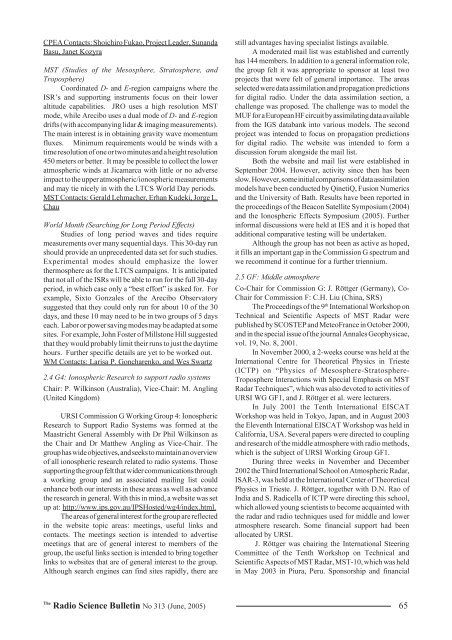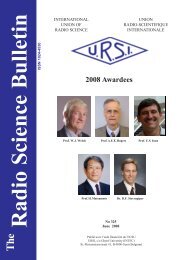Radio Science Bulletin 313 - June 2005 - URSI
Radio Science Bulletin 313 - June 2005 - URSI
Radio Science Bulletin 313 - June 2005 - URSI
- No tags were found...
You also want an ePaper? Increase the reach of your titles
YUMPU automatically turns print PDFs into web optimized ePapers that Google loves.
CPEA Contacts: Shoichiro Fukao, Project Leader, SunandaBasu, Janet KozyraMST (Studies of the Mesosphere, Stratosphere, andTroposphere)Coordinated D- and E-region campaigns where theISR’s and supporting instruments focus on their loweraltitude capabilities. JRO uses a high resolution MSTmode, while Arecibo uses a dual mode of D- and E-regiondrifts (with accompanying lidar & imaging measurements).The main interest is in obtaining gravity wave momentumfluxes. Minimum requirements would be winds with atime resolution of one or two minutes and a height resolution450 meters or better. It may be possible to collect the loweratmospheric winds at Jicamarca with little or no adverseimpact to the upper atmospheric/ionospheric measurementsand may tie nicely in with the LTCS World Day periods.MST Contacts: Gerald Lehmacher, Erhan Kudeki, Jorge L.ChauWorld Month (Searching for Long Period Effects)Studies of long period waves and tides requiremeasurements over many sequential days. This 30-day runshould provide an unprecedented data set for such studies.Experimental modes should emphasize the lowerthermosphere as for the LTCS campaigns. It is anticipatedthat not all of the ISRs will be able to run for the full 30-dayperiod, in which case only a “best effort” is asked for. Forexample, Sixto Gonzales of the Arecibo Observatorysuggested that they could only run for about 10 of the 30days, and these 10 may need to be in two groups of 5 dayseach. Labor or power saving modes may be adapted at somesites. For example, John Foster of Millstone Hill suggestedthat they would probably limit their runs to just the daytimehours. Further specific details are yet to be worked out.WM Contacts: Larisa P. Goncharenko, and Wes Swartz2.4 G4: Ionospheric Research to support radio systemsChair: P. Wilkinson (Australia), Vice-Chair: M. Angling(United Kingdom)<strong>URSI</strong> Commission G Working Group 4: IonosphericResearch to Support <strong>Radio</strong> Systems was formed at theMaastricht General Assembly with Dr Phil Wilkinson asthe Chair and Dr Matthew Angling as Vice-Chair. Thegroup has wide objectives, and seeks to maintain an overviewof all ionospheric research related to radio systems. Thosesupporting the group felt that wider communications througha working group and an associated mailing list couldenhance both our interests in these areas as well as advancethe research in general. With this in mind, a website was setup at: http://www.ips.gov.au/IPSHosted/wg4/index.html.The areas of general interest for the group are reflectedin the website topic areas: meetings, useful links andcontacts. The meetings section is intended to advertisemeetings that are of general interest to members of thegroup, the useful links section is intended to bring togetherlinks to websites that are of general interest to the group.Although search engines can find sites rapidly, there arestill advantages having specialist listings available.A moderated mail list was established and currentlyhas 144 members. In addition to a general information role,the group felt it was appropriate to sponsor at least twoprojects that were felt of general importance. The areasselected were data assimilation and propagation predictionsfor digital radio. Under the data assimilation section, achallenge was proposed. The challenge was to model theMUF for a European HF circuit by assimilating data availablefrom the IGS databank into various models. The secondproject was intended to focus on propagation predictionsfor digital radio. The website was intended to form adiscussion forum alongside the mail list.Both the website and mail list were established inSeptember 2004. However, activity since then has beenslow. However, some initial comparisons of data assimilationmodels have been conducted by QinetiQ, Fusion Numericsand the University of Bath. Results have been reported inthe proceedings of the Beacon Satellite Symposium (2004)and the Ionospheric Effects Symposium (<strong>2005</strong>). Furtherinformal discussions were held at IES and it is hoped thatadditional comparative testing will be undertaken.Although the group has not been as active as hoped,it fills an important gap in the Commission G spectrum andwe recommend it continue for a further triennium.2.5 GF: Middle atmosphereCo-Chair for Commission G: J. Röttger (Germany), Co-Chair for Commission F: C.H. Liu (China, SRS)The Proceedings of the 9 th International Workshop onTechnical and Scientific Aspects of MST Radar werepublished by SCOSTEP and MeteoFrance in October 2000,and in the special issue of the journal Annales Geophysicae,vol. 19, No. 8, 2001.In November 2000, a 2-weeks course was held at theInternational Centre for Theoretical Physics in Trieste(ICTP) on “Physics of Mesosphere-Stratosphere-Troposphere Interactions with Special Emphasis on MSTRadar Techniques”, which was also devoted to activities of<strong>URSI</strong> WG GF1, and J. Röttger et al. were lecturers.In July 2001 the Tenth International EISCATWorkshop was held in Tokyo, Japan, and in August 2003the Eleventh International EISCAT Workshop was held inCalifornia, USA. Several papers were directed to couplingand research of the middle atmosphere with radio methods,which is the subject of <strong>URSI</strong> Working Group GF1.During three weeks in November and December2002 the Third International School on Atmospheric Radar,ISAR-3, was held at the International Center of TheoreticalPhysics in Trieste. J. Röttger, together with D.N. Rao ofIndia and S. Radicella of ICTP were directing this school,which allowed young scientists to become acquainted withthe radar and radio techniques used for middle and loweratmosphere research. Some financial support had beenallocated by <strong>URSI</strong>.J. Röttger was chairing the International SteeringCommittee of the Tenth Workshop on Technical andScientific Aspects of MST Radar, MST-10, which was heldin May 2003 in Piura, Peru. Sponsorship and financialThe<strong>Radio</strong> <strong>Science</strong> <strong>Bulletin</strong> No <strong>313</strong> (<strong>June</strong>, <strong>2005</strong>) 65
















